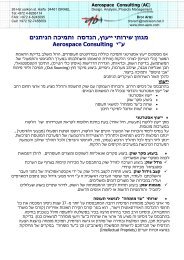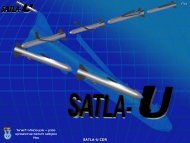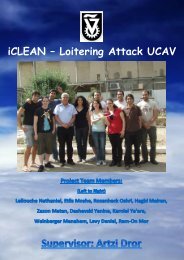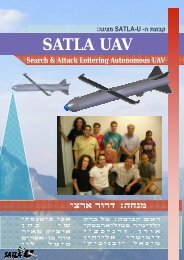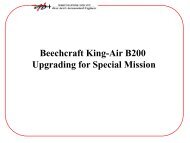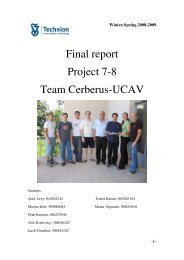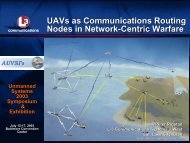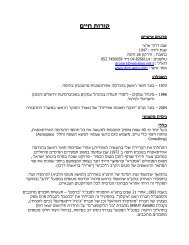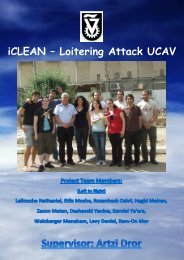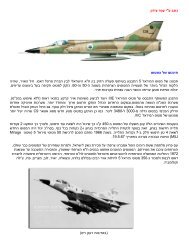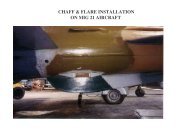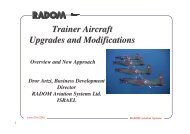Israel Aircraft Industries (IAI) Lavi - aero.com
Israel Aircraft Industries (IAI) Lavi - aero.com
Israel Aircraft Industries (IAI) Lavi - aero.com
You also want an ePaper? Increase the reach of your titles
YUMPU automatically turns print PDFs into web optimized ePapers that Google loves.
Elta EL/M-2035 Multi-Mode Pulse Doppler Radar<br />
The Elta EL/M-2035 multi-mode pulse-Doppler radar was a development of the Elta EL/M-2021B<br />
multi-mode Doppler radar of the <strong>IAI</strong> Kfir-C2. The radar was very advanced and had a coherent<br />
transmitter and a stable multi-channel receiver for reliable look-down performance over a broad<br />
band of frequencies and for high resolution mapping. An Elta programmable signal processor,<br />
backed by a distributed, embedded <strong>com</strong>puter network, would provide optimum allocation of<br />
<strong>com</strong>puting power and great flexibility for growth and the updating of algorithms and systems growth.<br />
The radar could provide speed and position of targets in the air and on the ground, and could provide<br />
the pilot with a map of the terrain the <strong>Lavi</strong> was overflying. It could track several targets at 46 km<br />
distance in at least five air-to-air modes (automatic target acquisition, boresight, look down, look up<br />
and track while scan (TWS)). The radar had at least two air-to-ground modes (beam-sharpened<br />
ground mapping/terrain avoidance ans sea search). After the cancellation of the <strong>Lavi</strong> program the<br />
radar was offered for multi-role fighter retrofits, including the Denel Cheetah E.<br />
Elta/Elistra Electronic Warning System<br />
The electronic warning system of the <strong>Lavi</strong> was designed by Elta and Elistra and was based on an<br />
active and passive integrated electronic support measures/electronic countermeasures (ESM/ECM)<br />
<strong>com</strong>puter-system, and was capable of rapid threat identification and automatic deception and<br />
jamming of enemy radar stations. It was carried internally. This system could also be used in the<br />
future environment of more sophisticated enemy radar systems. The <strong>Lavi</strong> could eventually carried<br />
podded power-managed noise and deception jammers.<br />
Lear Siegler/MBT Fully Digital Flight Control System<br />
The Lear Siegler/MBT fully digital flight control system for the <strong>Lavi</strong> had quadruplex redundancy<br />
with stability augmentation, and had no mechanical backup. It <strong>com</strong>promised two boxes, with two<br />
digital channels built into each box. The twin-box configuration hinged on the survivability issue,<br />
which was given great emphasis. If one was damaged, the other would provided sufficient control<br />
authority to regain base. Each digital channel had associated with it an analogue channel that could<br />
have take over its function in the event of a failure. The design total failure rate was not greater than<br />
1 in 10 7 hours. The program was launched in October 1982, and production deliveries would began in<br />
1988.<br />
Elbit SMS-86 Stores Management System<br />
Elbit was selected during early 1985 to develop the SMS-86 stores management system for the <strong>Lavi</strong>.<br />
The system, which was fully <strong>com</strong>puter-controlled, <strong>com</strong>promised two units. The stores management<br />
processor included one MIL-STD-1750 <strong>com</strong>puter and two MIL-STD-1553B data-bus interfaces. The<br />
armament interface unit included a stores interface <strong>com</strong>patible with the MIL-STD-1750. The SMS-86<br />
was capable of managing both conventional and smart weapons.<br />
Armament<br />
The weapons carriage of the <strong>Lavi</strong> was mainly semi-conformal, thus reducing drag, with two<br />
hardpoints beneath each wing (the inboard pair was wet for the carriage of two 2,548 liter auxilliary<br />
fuel tanks), plus the wingtip rail and seven underfuselage hardpoints (three tandem pairs plus one on<br />
the centreline). The main air-to-air weapon was to be the Rafael Python 3, an <strong>Israel</strong>i-designed short<br />
range infra-red (IR) homing dogfight air-to-air missile, while a DEFA Type 552 (Improved) cannon<br />
was housed in the starboard wing root. The air-to-ground weapons used by the <strong>Lavi</strong> included the<br />
Hughes AGM-65B Maverick, the <strong>IAI</strong> Gabriel IIIAS, rockets, and the Mk 81, Mk 82, Mk 83, Mk 84,<br />
and M117 bombs.



